Billed the heavyweight clash of the weekend, Chris Wilder and Sheffield United travelled to Elland Road to face off with Leeds and Marcelo Bielsa. With both teams battling it out with Norwich City for the two automatic promotion spots we were guaranteed fireworks.
Lineups
Bielsa, as he has done throughout his career, sent out his usual core group of players, with an unchanged XI from the comfortable midweek victory over Reading.
Wilder, however, made a number of changes from their 2-0 victory against Rotherham. Martin Craine, Billy Sharp and David McGoldrick coming in for Gary Madine, Scott Hogan and Kieran Dowell. This also saw a slight shift in shape with the Blades setting up in a clear 5-3-2 out of possession. This meant a more advanced role for Chris Basham and a return to the right-sided centre-back spot for Cranie.
Although this could be seen as a conservative move from Wilder, Basham’s ability to control the tempo of play was key. Coupled with his talent to break lines through dribbling caused issues for Leeds all afternoon long.
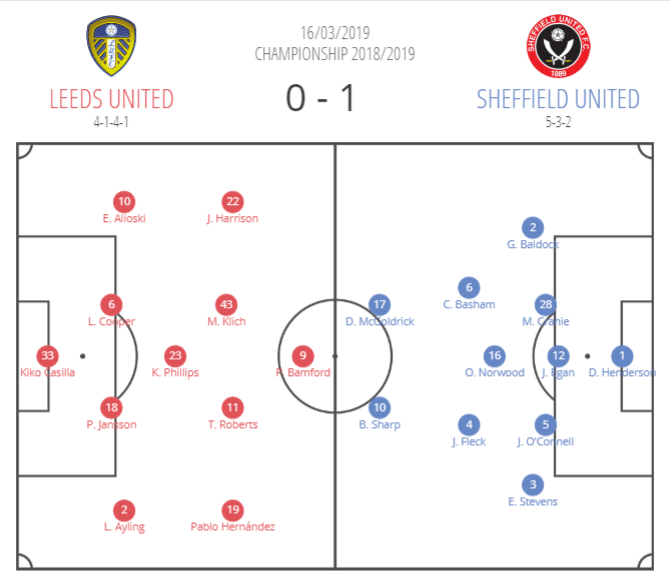
Weathering the storm
As expected, Leeds started the game with a high tempo, a high press and an urgency to get that first goal. In the opening quarter of the game, Leeds dominated the ball, committed numbers forward and totalled six shots.
During this period Sheffield United sat in a standard 5-3-2. They used their back five to cover Patrick Bamford and the accompanying midfield runners. The midfield three then sat in front trying to cut out the third-line passes into the attacking third. Sharp and McGoldrick them attempted to force the home team into errors in their defensive third to provide the Blades with opportunistic attacking chances.
Due to the defensive cover that a back five provides, the attacking and midfield lines from Sheffield United could position themselves higher up the field. As you can see in the image below, Leeds have shifted into their usual 2-3 shape in the first two lines. The Blades have matched this with the own 2-3 creating numerical equality.
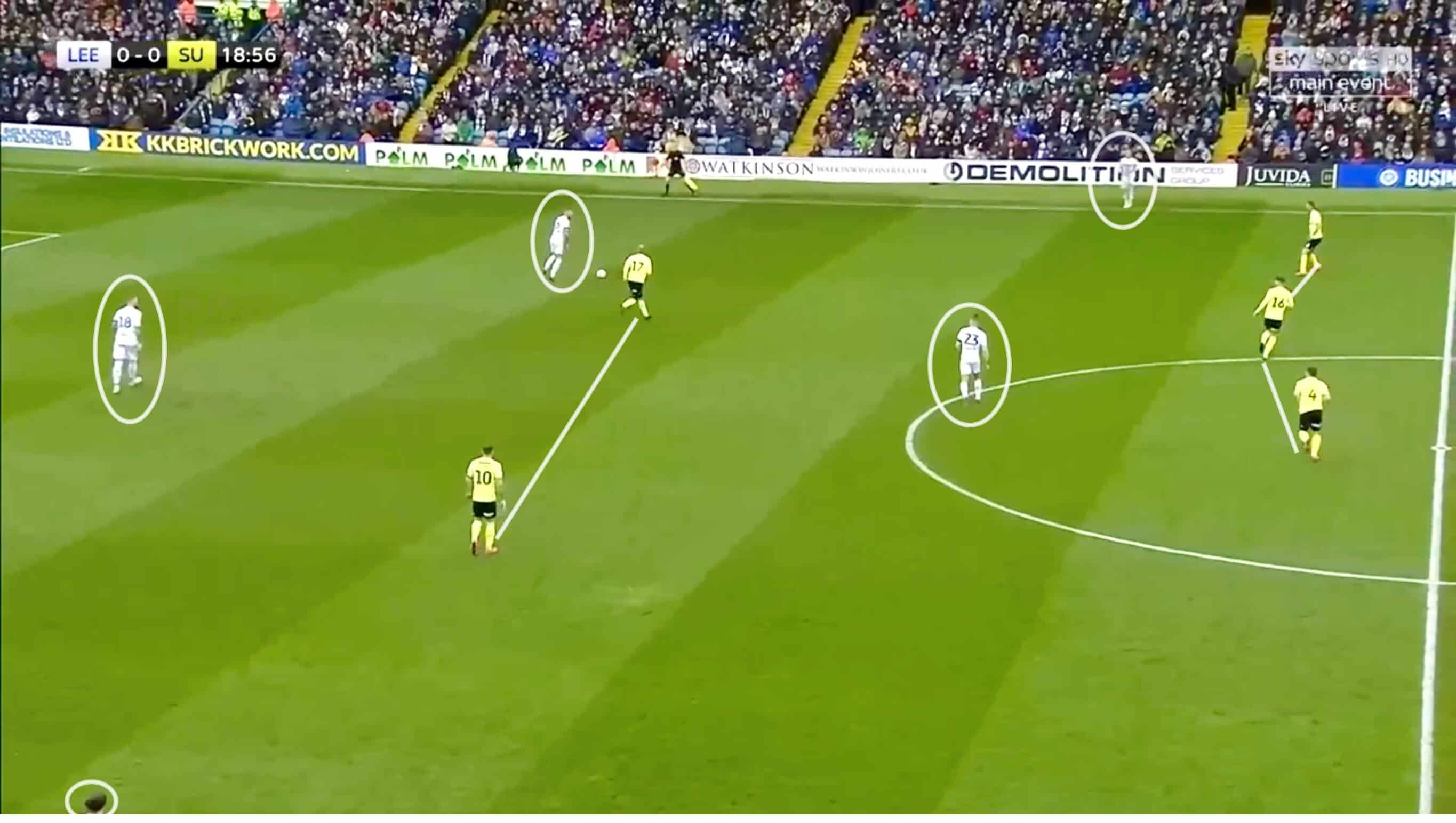
The gaps between the lines for the Blades do provide space for Phillips to position himself between the lines. They sacrifice this however in favour of narrow positioning on the strong side of the field. This positioning allows them to use their cover shadows to stop penetrative passes into the Leeds front five.
Throughout the first half, this left the Leeds back line with no option other than to go long. Wilder set traps for this with his central defenders generally winning the first ball and heading out to the half and wing-space channels. Here the wing-back and a dropping midfielder would double the ball to win back possession.
On the occasions that Leeds managed to break the Sheffield United first line, the Blades set up in a part zonal and part man orientated defence. The midfield three would become ball and man orientated with Oliver Norwood often dropping in to man-mark Roberts.
As you can see in the below image the ball-side one of the midfield three, in this case John Fleck, puts direct pressure on the ball carrier. Norwood takes Tyler Roberts out of the game through man marking. This leaves Basham to provide the cover on Kalvin Phillips so that Leeds cannot switch play through their defensive midfielder.
This in turn means that Leeds either have to use combination play in a numbers down situation on the near side, or play a low percentage long ball to switch play.
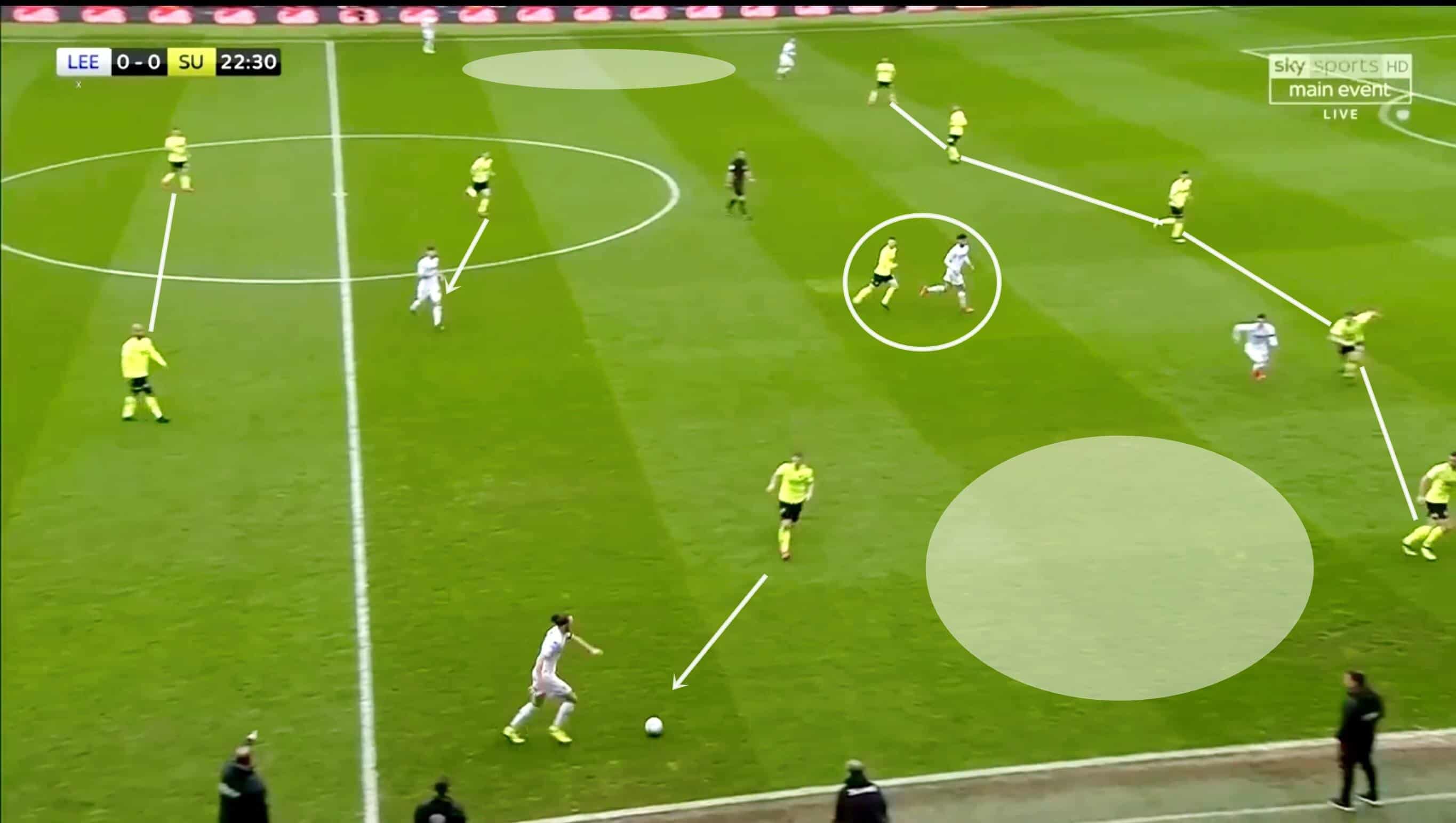
This pattern continued throughout the first half. Leeds dominated possession but couldn’t work their usual playmakers in Pablo Hernandez and Roberts into positions to hurt the Blades. Although the shots on goal continued to mount for the home side, they were unable to register an attempt on target.
Up, back, through… almost
Although Leeds dominated the first half between the penalty boxes, it was often their execution of the final ball of shot that let them down. In the below image, Basham is caught out of position and too high up the field. This creates an issue for the Blades who now find their midfield in a numbers down situation.
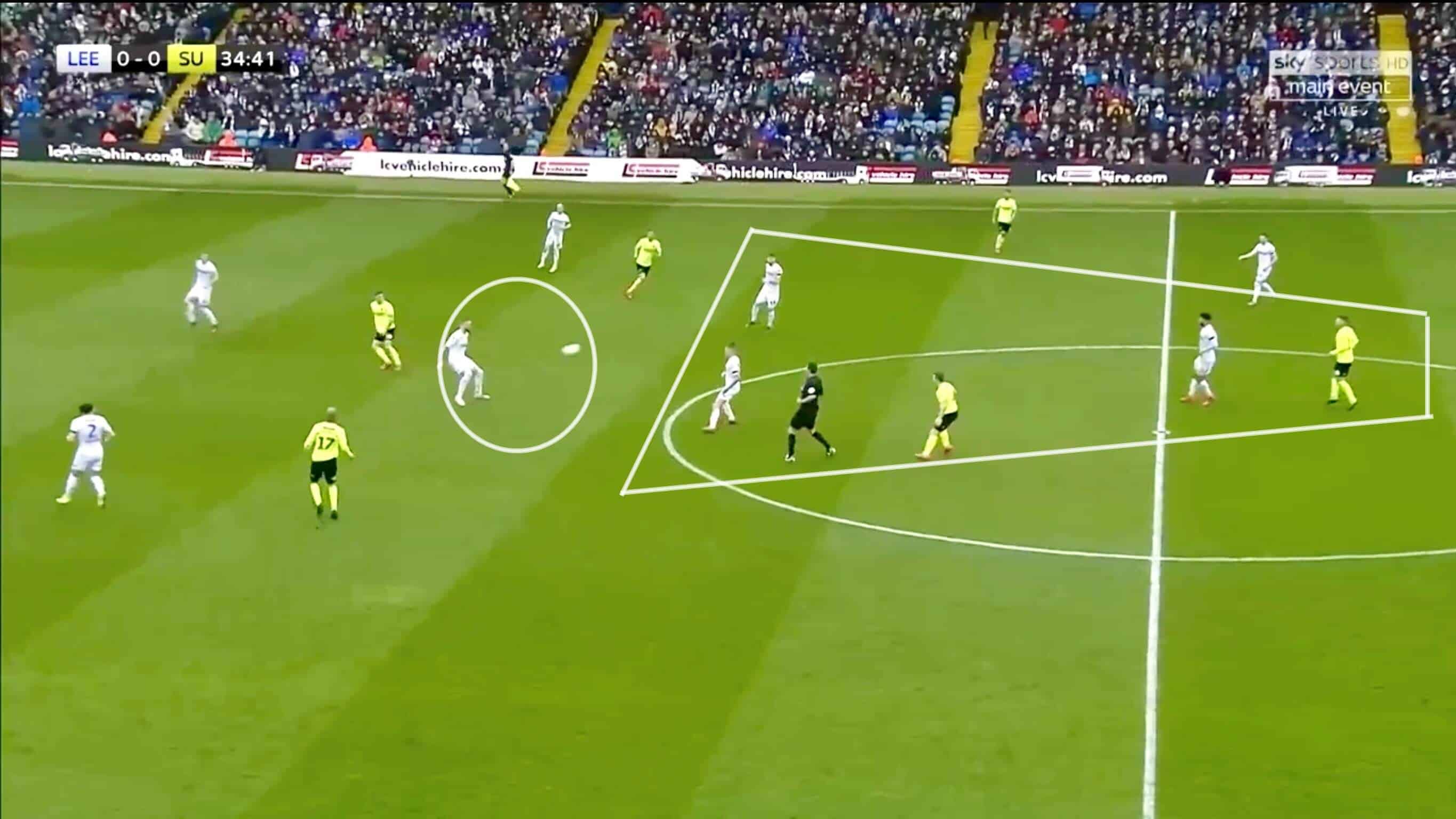
Leeds look to capitalise on this through the use of Bielsa’s more favoured patterns of play, the up-back-through. The aim of this is to create space for the third man to be able to receive the ball in space. In this instance, the ball is won by Pontus Jansson who manages to find the feet of Roberts. This pass draws Norwood towards Roberts as the ball comes, making sure that the Leeds man cannot turn.
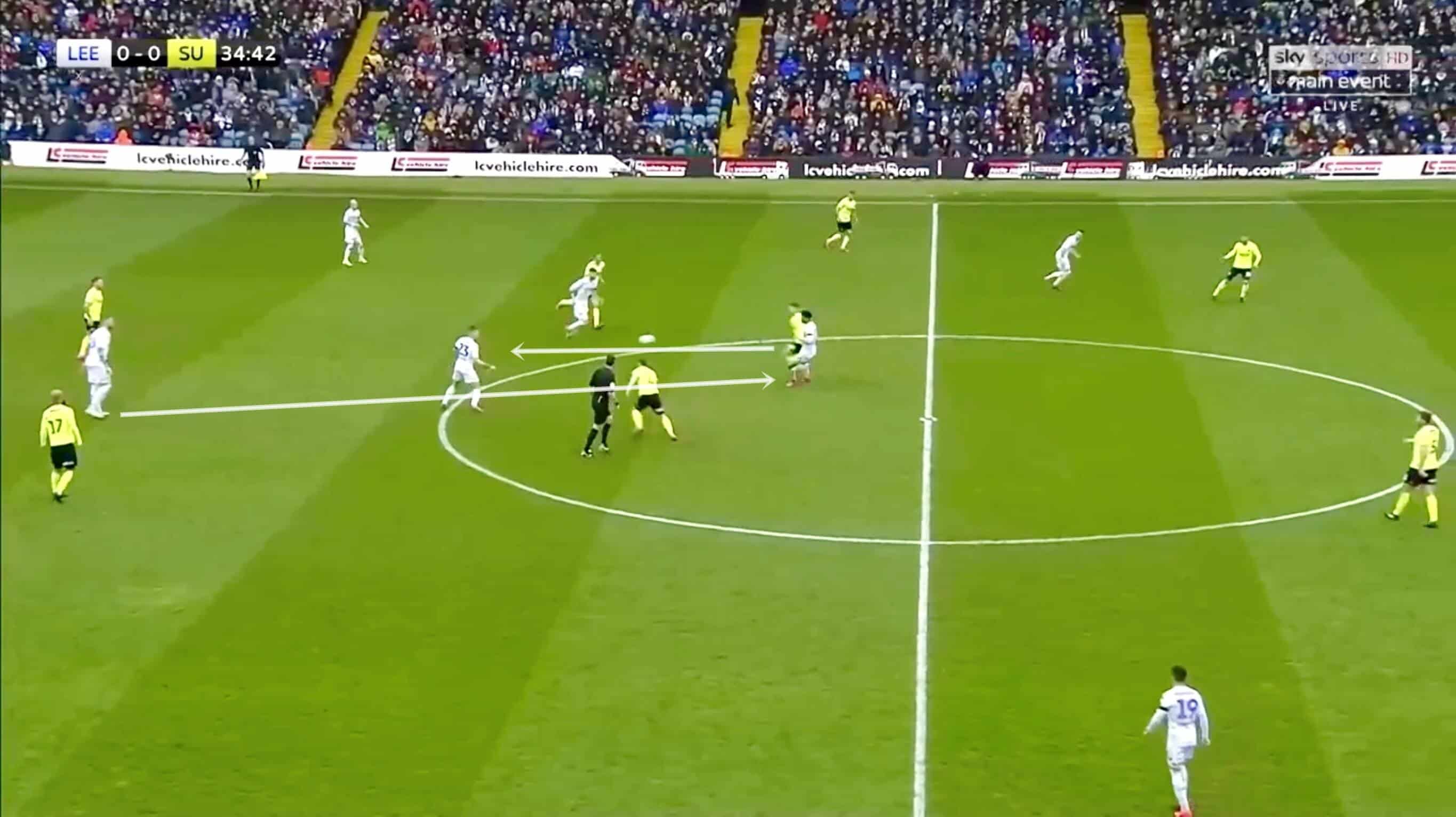
By dropping the ball off to Phillips instead of trying to turn, Roberts has now created space behind the midfield line in which to receive. A simple third-line pass back to Roberts from Phillips now has the Leeds player carrying the ball at the Blades defence.
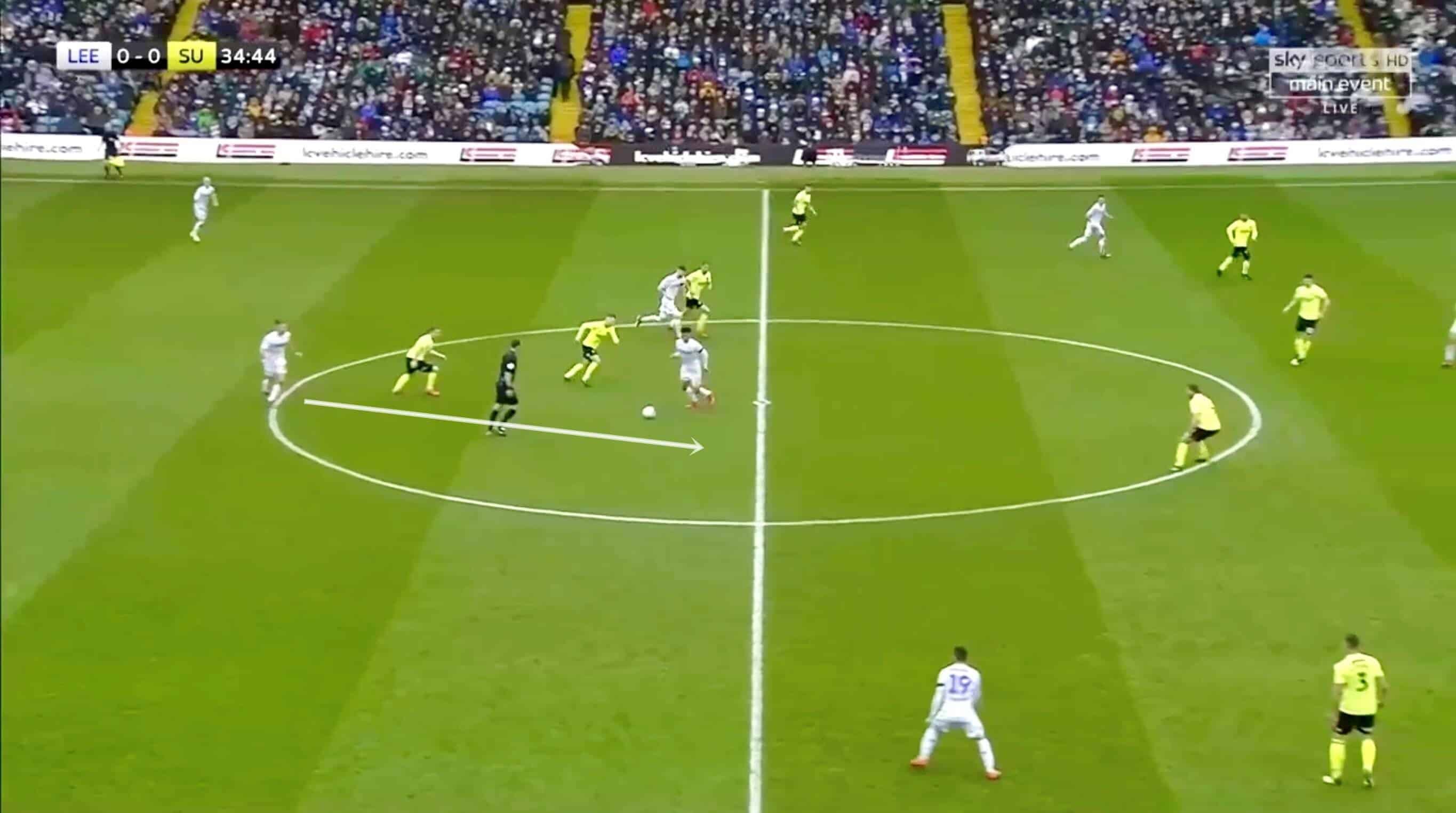
This then has a knock-on effect in relation to the back five. Due to the midfield three being played through, a member of the back five now has to step to the ball. In the above image, you can see Jack O’Connell make a move toward the ball. This move creates the opportunity for Bamford to make a run into the space vacated by O’Connell.
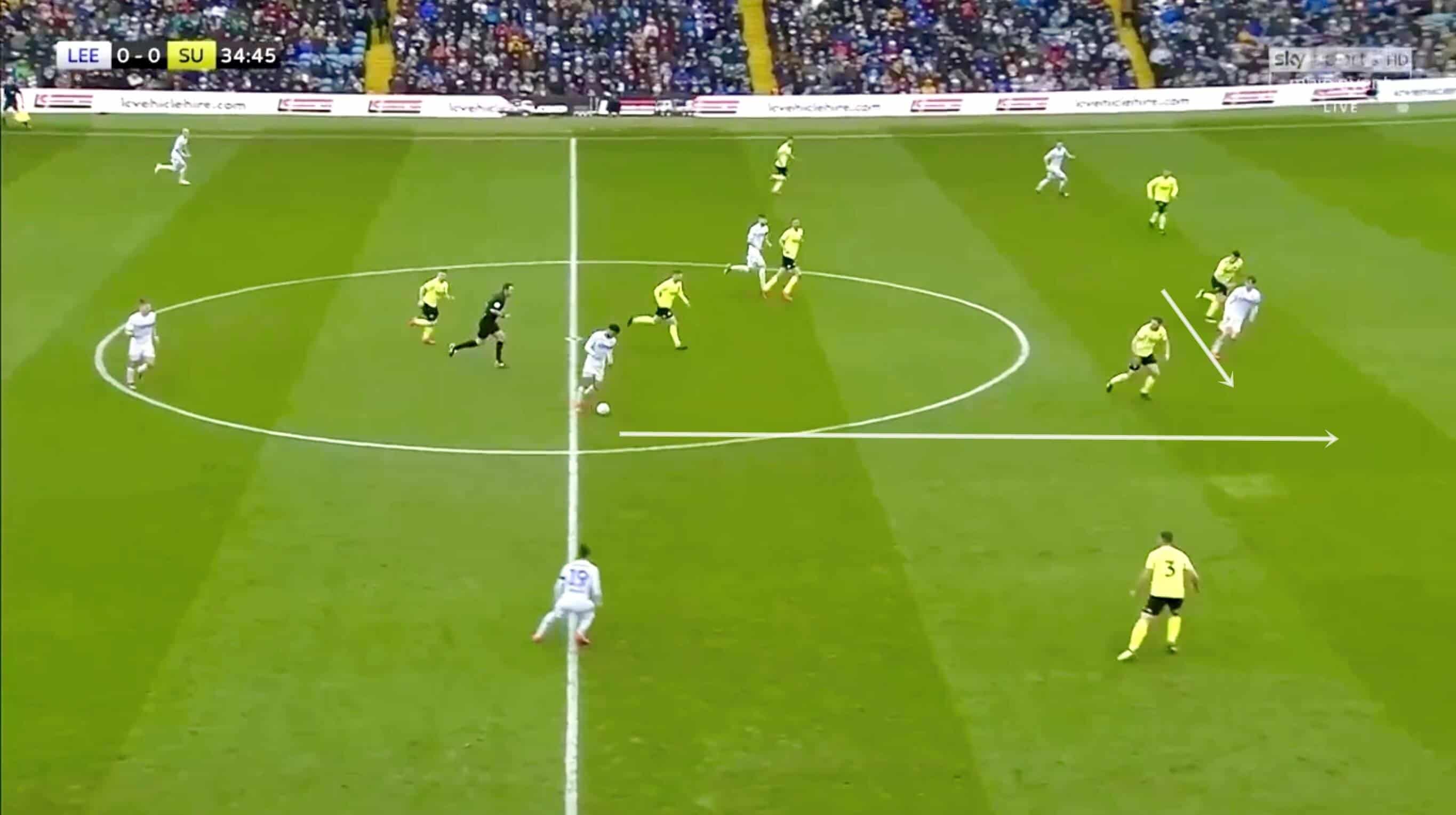
Unfortunately for Leeds, as on many occasions in the first 45 minutes, the build-up was excellent, but the final ball or shot let them down. With what should be an easy through-ball for a player of Roberts’ standards, the Leeds midfielder overhits the pass. Bamford’s run was well timed, but once again ends up in nothing for the home side.
Second half
Neither manager made any changes at hafl time. As such the start of the second half followed a similar pattern to the first. Leeds saw plenty of the ball, with Sheffield United happy to set up in their mid-block. As the game continued, Basham, Norwood and Fleck grew into their roles.
By being able to possess the ball through the middle third, it created spaces for their wing-backs, George Baldock and Enda Stevens, to advance into. Throughout the season the half spaces have been the Blades’ primary chance creation corridor, and they looked to take advantage of this as the game progressed.
In the 71st minute, the Blades got the breakthrough they had been looking for through Basham’s well-placed drive into the bottom corner. Although Leeds continued to dominate throughout the middle third, they could not find the equaliser and Wilder’s men took all three points back to Brammell Lane.
It was reminiscent of the job the Blades did at the Hawthorns earlier in the season. What it has done is set up one of the most hotly contested ends to a Championship season in recent memory with three footballing sides vying for that elusive Premier League place. It is exactly what the English Football League needed.
Waiting for mistakes
One of the keys in the second half was Sheffield United’s patience in defence and composure in possession. Perhaps a little overawed in the first half, the second period showed a more composed Sheffield United giving away possession 30% fewer times than the home team.
It is not only the number of times that Leeds gave away possession, however, but the areas on the field in which they did so.

As you can see in the above image, in which Leeds (red) are attacking left to right, the ball was given away 61 times during the game. What is also immediately noticeable however is the difference in the number of times each team gave the ball away in their own half.
Sheffield United only gave up a turnover six times in their own half compared to Leeds giving away the ball 14 times in their own territory. As we know that balls recovered in the opposition half lead to the highest percentage of goals in football. This is a worrying statistic for Bielsa.
This came about mostly through individual errors on the home team’s part. The Blades’ defensive positioning left the Leeds players with fewer short passing options than normal. This forced the Leeds players into moments of hesitation, during which the Blades were able to pressure the ball.
Bielsa is well known for pushing numbers forwards, going for the win and often struggling in transition outside of pure effort. This high risk, high reward football has led his Leeds team to a great season so far. In football, however, that does not split phases of the game. Defensive positioning in attack is key, and this pragmatism is still missing from Leeds’ play.
Basham’s bullet to Bielsa
Following the theme above in regards to the lack of defensive positioning when on the ball, the Blades took advantage of this to take the lead. Bielsa and Leeds are well known for immediate pressure being put on the opposition when possession is turned over. Taking a first step towards the ball can cause issues.
In the below instance, Leeds have followed the principle of at least plus one at the back. What they haven’t done, however, is think about positional superiorities.
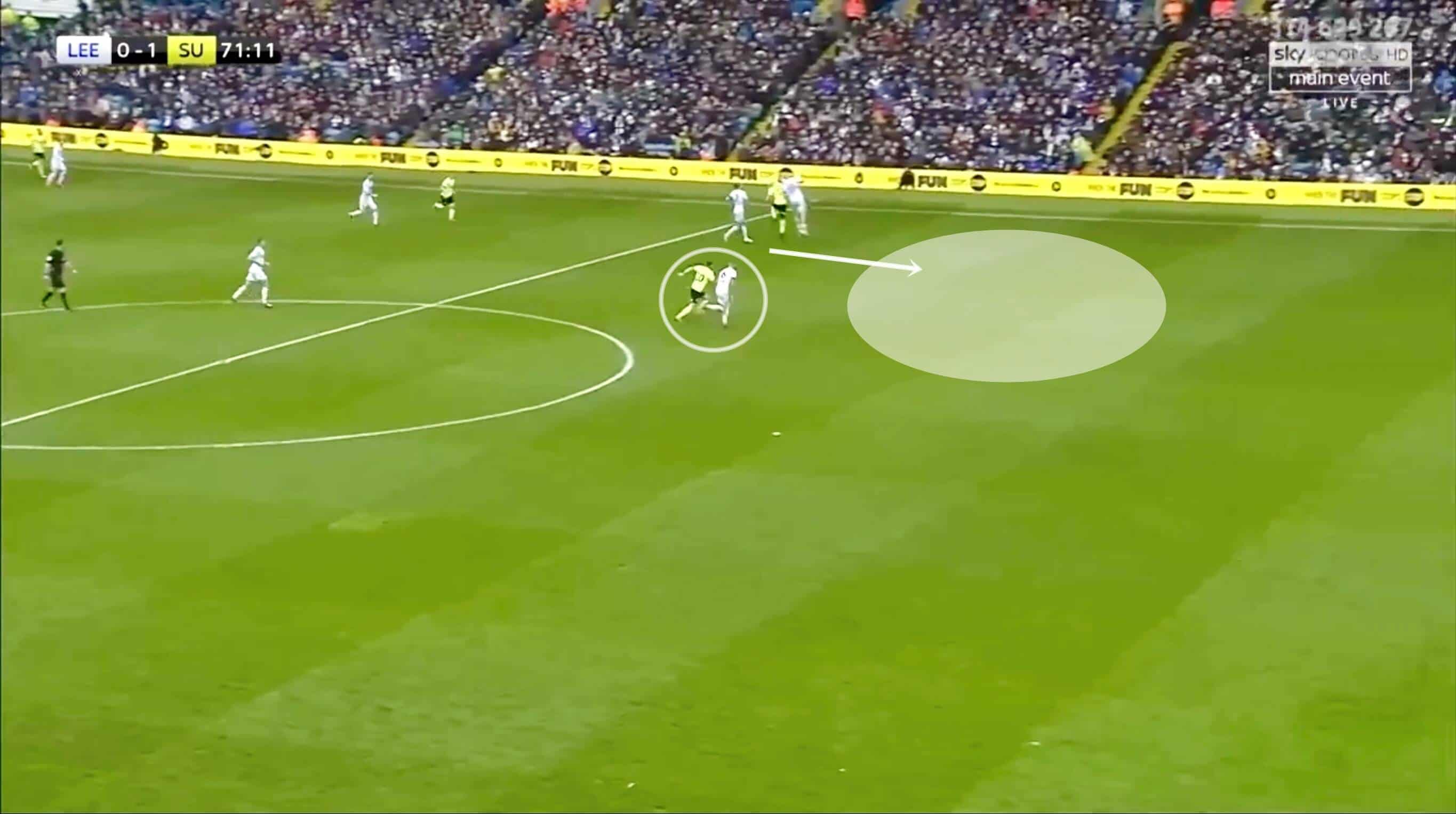
In the image, Leeds are in a 5v3 situation defensively. From a statistical standpoint, this should be enough to deal with the Blades’ long-ball counter-attack. When you look more closely, however, the positional sense of the Leeds defenders causes huge issues resulting in a Sheffield United goal.
You can see Luke Ayling and Jansson challenging McGoldrick, with Phillips covering the central space. This leaves Sharp one on one against Cooper with no covering player. If McGoldrick wins the ball, as in this instance, four of the five Leeds players are now out of the game.
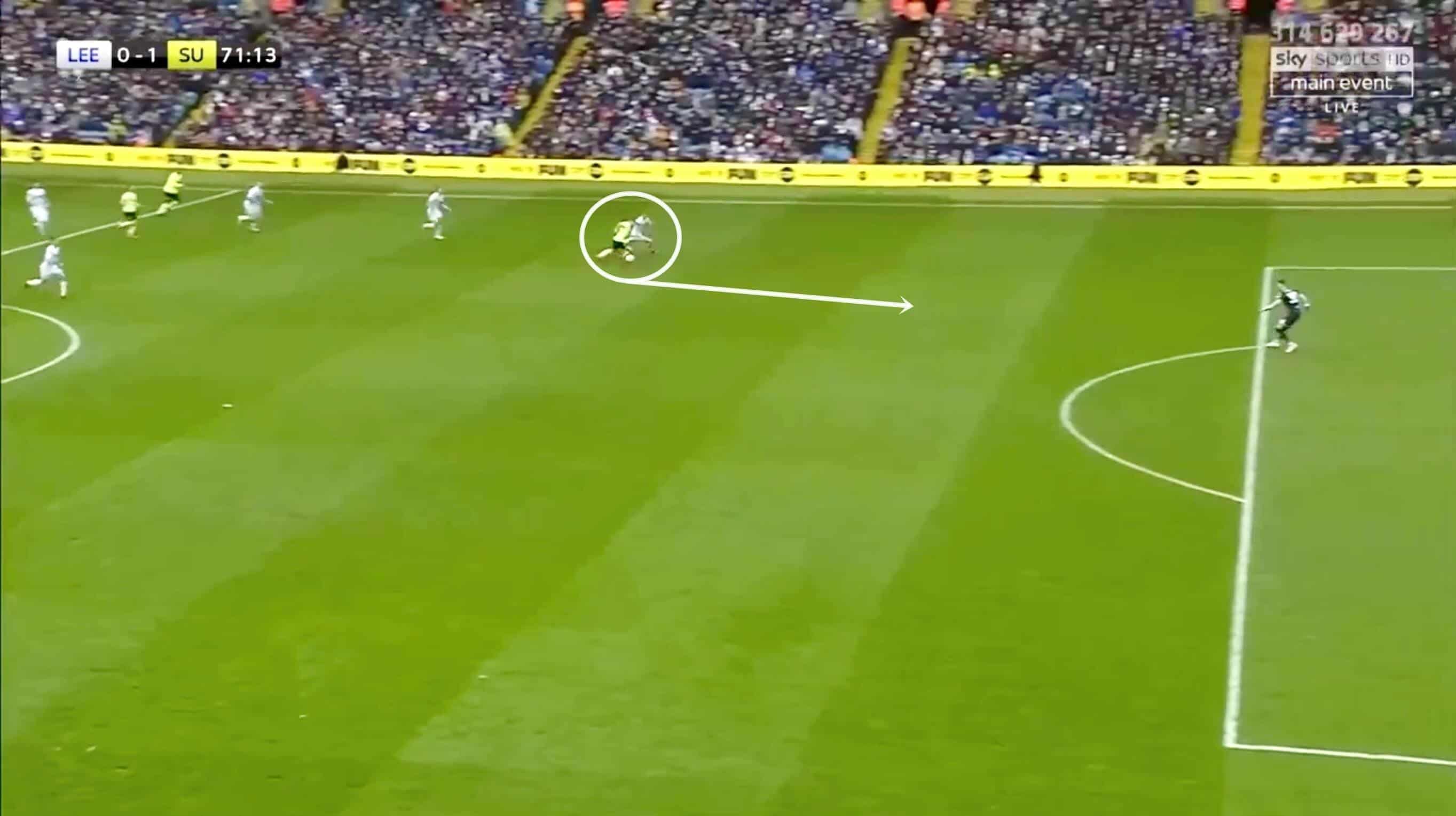
From here Leeds now find themselves in a desperate sprint back to try and help Cooper who is isolated against the faster and more technical Sharp.
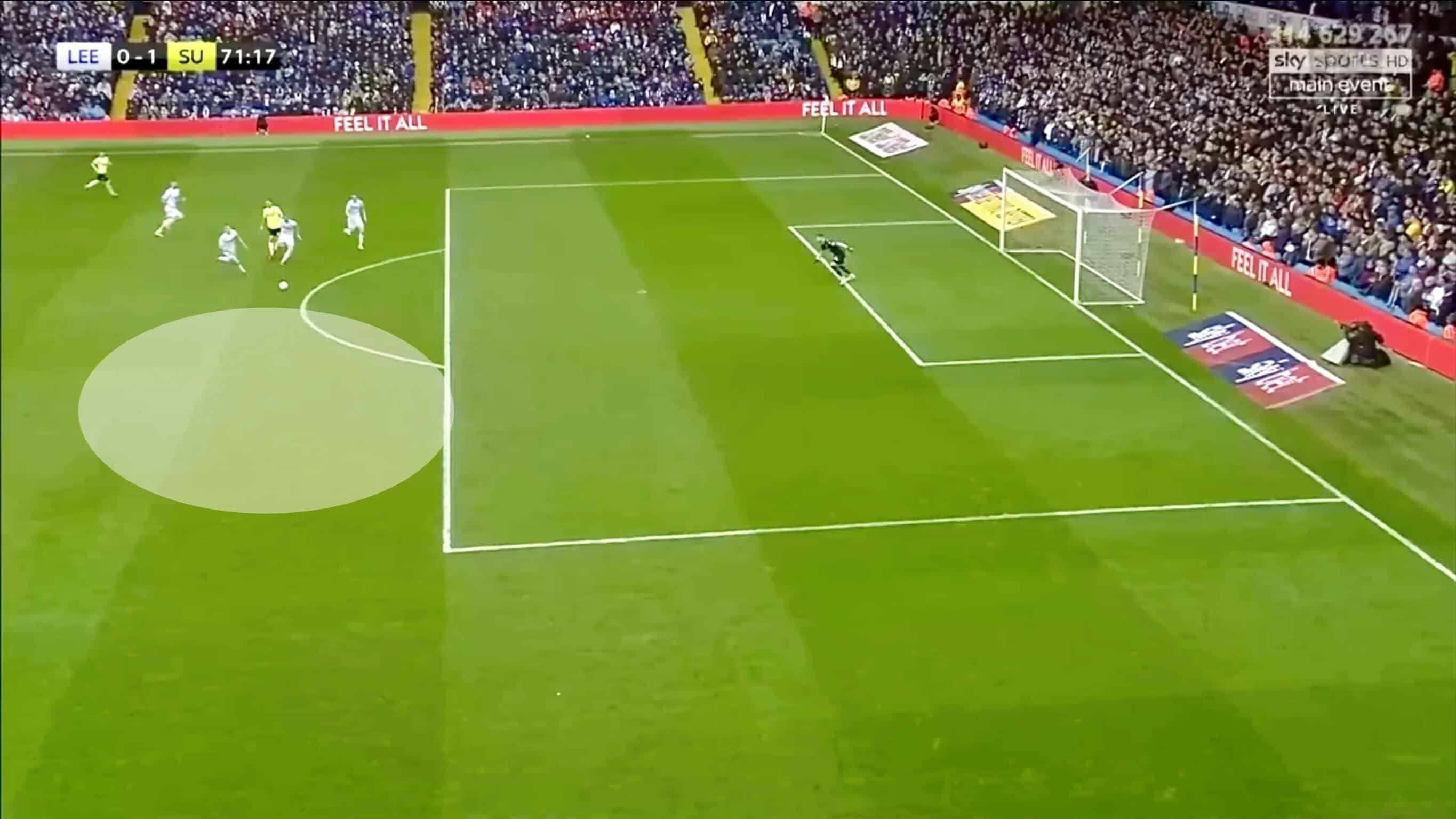
The issue with this is that in these moments of panic, players become less aware of their surroundings. This causes all four Leeds players to become ball orientated and put direct pressure on Sharp. As you can see in the above image, this creates a huge amount of space for supporting runs from the Blades.
Ideally, Bielsa would have liked two players to pressure the ball; one to slow Sharp, and one to be ball orientated in terms of trying to win possession. The next two should have looked to cover the most dangerous spaces and passes available to Sharp. This would have resulted in any Sheffield United players not being able to take possession from Sharp. Unfortunately, this didn’t happen and Sharp found his teammate’s run perfectly.
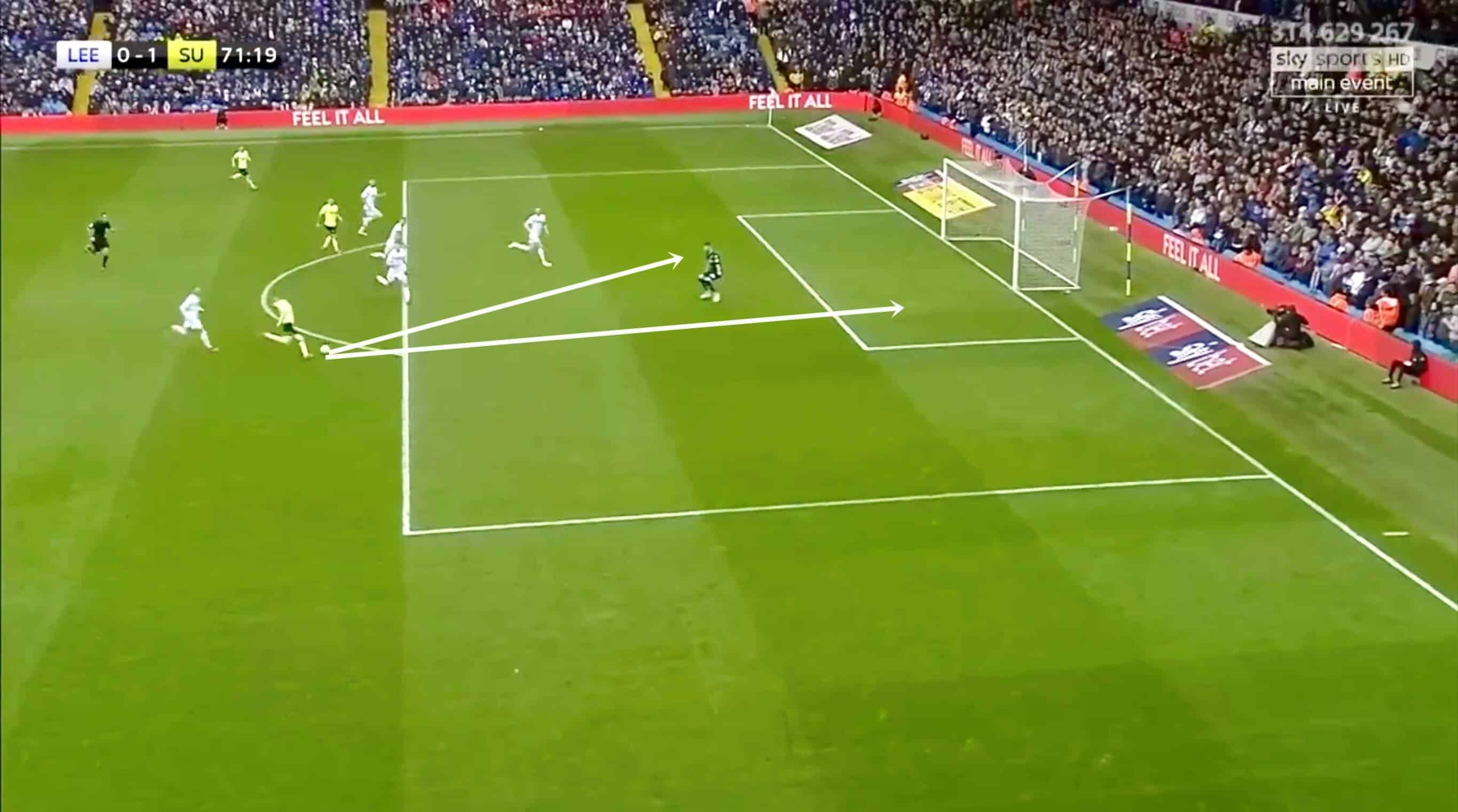
Basham was this supporting run. Instead of being ball orientated and taking away space from Sharp, he makes his run into space. This allows Sharp the chance to play a simple horizontal ball into Basham. From here, he steadies himself and places the ball onto the weighted side of the goalkeeper.
This means that Kiko Casilla cannot push off and get the leverage needed to save the shot. It was a well-executed counter-attack, that really should have been handled by Leeds.
Conclusion
In what was an enthralling clash atop the Championship, Wilder and Sheffield United left with all three points. Bielsa and Leeds will be ruing their missed opportunities. Although they had a total of 17 shots, they failed to register a single one on target.
Holding the home side to no shots on target will have been beyond Sheffield United’s wildest dreams, and another very well executed smash-and-grab job has left the Blades in the automatic promotion spots.
With six games left, there is still a great amount to play for. Both Sheffield United and Leeds will feel as though they have enough to take one of the two automatic spots. In this instance, the patient, calm and well-drilled approach of Wilder got the better of Bielsa. What remains to be seen however is whether it will be the high-risk high-reward football of Bielsa or the pragmatic tactically nuanced approach of Wilder that ends up having the last laugh.
If you love tactical analysis, then you’ll love the digital magazines from totalfootballanalysis.com – a guaranteed 100+ pages of pure tactical analysis covering topics from the Premier League, Serie A, La Liga, Bundesliga and many, many more. Buy your copy of the March issue for just ₤4.99 here, or even better sign up for a ₤50 annual membership (12 monthly issues plus the annual review) right here.






Comments